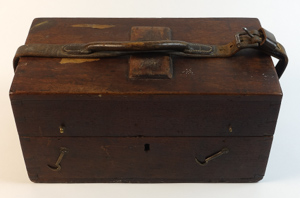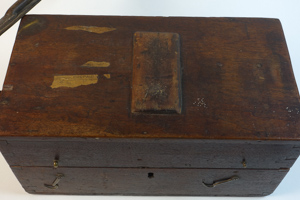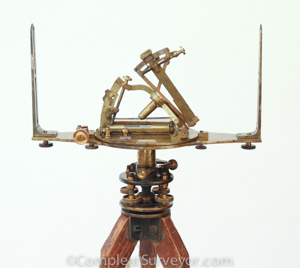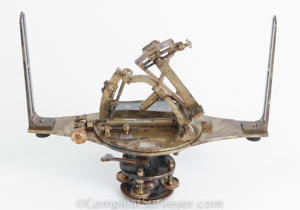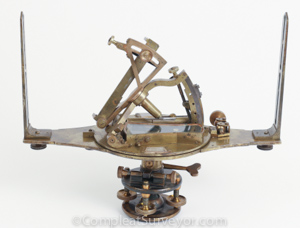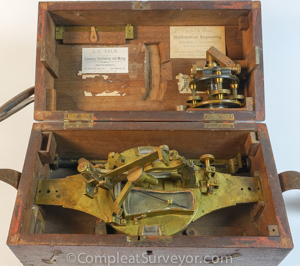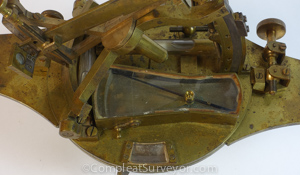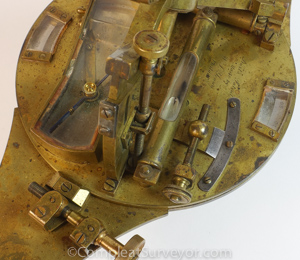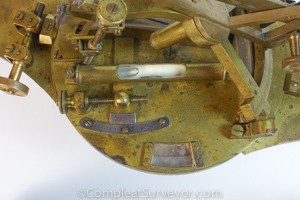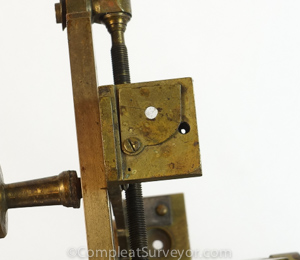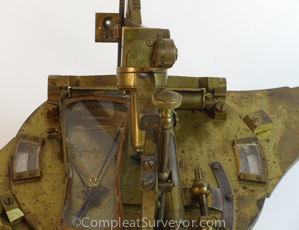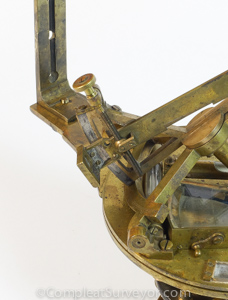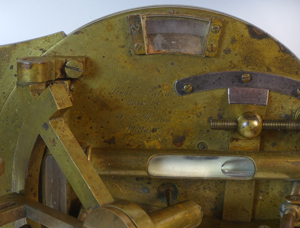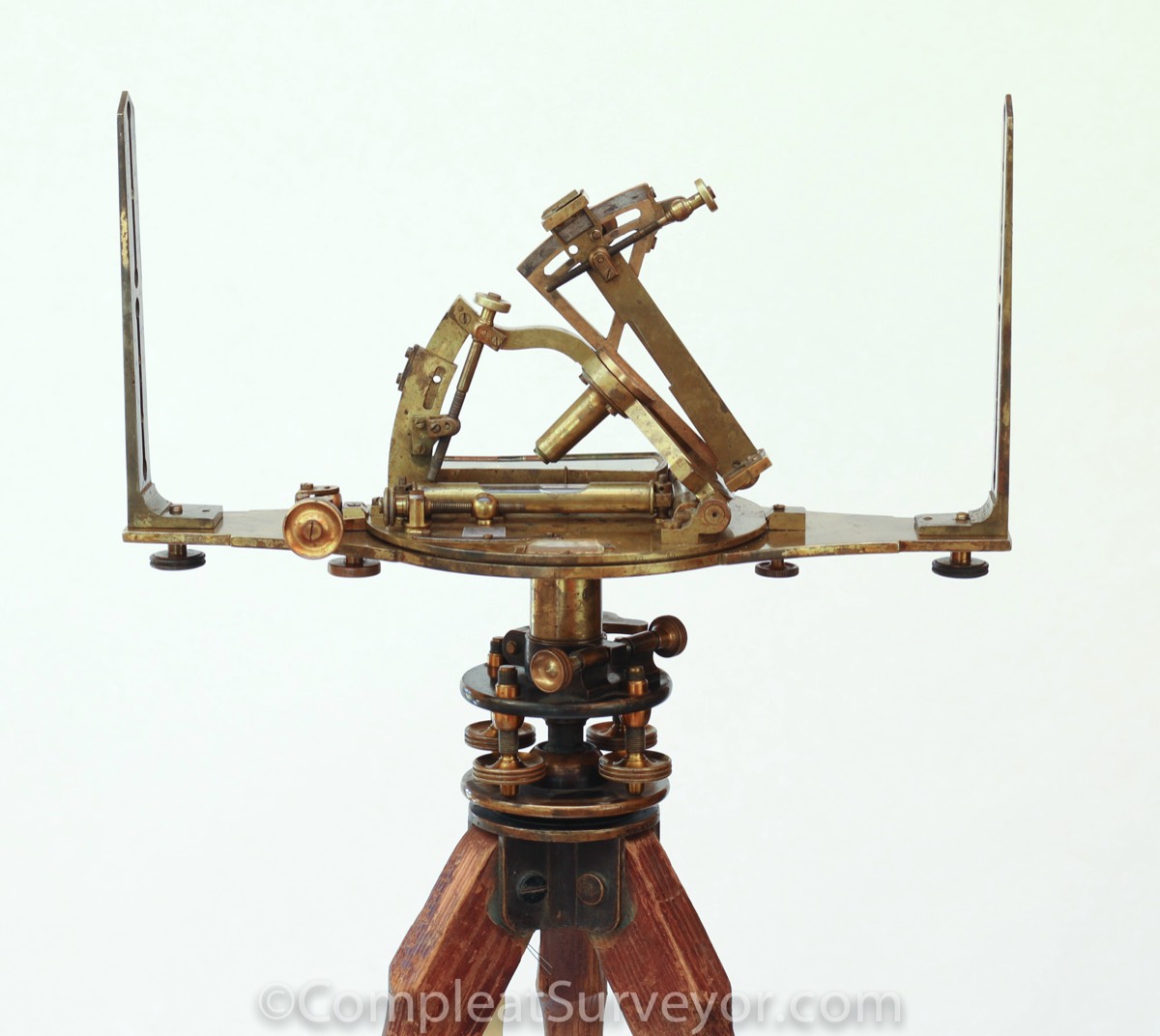
The First Solar Compass Made - 1840
A Truely Unique Opportunity to Own the Prototype of the Most Important Surveying Instrument in America History
This is one of the most valuable surveying instrument ever made in America.
Robert C. (Bob) Miller owned this solar compass for many years. Bob was a physicist, who passionately researched the history of mathematical instruments made in Pennsylvania. He was the pre-imminent authority on Burt's Solar Compasses, publishing a book "Burt's Solar Compass - The Development, Manufacture and Daily Usage" in 2010". Bob was also the pre-imminent authority on instruments made by William Young, publishing "Dating Young Instruments" in Rittenhouse, Journal of the American Scientific Instrument Enterprise, Vol 5, No. 1 at page 21 et seq. According to Bob, the instrument offered here was the VERY FIRST Burt Solar Compass ever made. This was the solar compass that William A. Burt took to the Committee on Science and the Arts of the Franklin Institute in December 1840 to examine (with the committee concluding that the device was a "very important improvement over the ordinary surveyor's compass, and deserving of great commendation"). This was the solar compass that would become the pattern for the most important surveying instrument every produced in America.
I've appreciated the significance of this solar compass for 13 years. Bob and my father, Bud Uzes, exchanged numerous calls and emails while Bob was authoring his Burt Solar Compass book. In 2005, Bob and Bud owned 4 of the 8 known pre-1853 Young Solar Compasses, and they compared every single detail of the four instruments. Bob also asked Bud to review his draft book various times for accuracy, and Bud was sending me drafts of the book and pics of the 4 early Young solar compasses all the time late in 2005. Bob was also communicating with the Smithsonian, which also owned a very early Young solar compass. Please see my webpage on Pre-Civil War Young Solar Compasses, which shows some of the evolution of design that occurred during the early years of making Burt Solar Compasses, including important design changes that were made immediately after Young and Burt put together the First Solar Compass pass offered here.
There are three labels on the top of the box - Young & Sons, a partial label from Sala, as the successor to the John Roach Company, and a Sala label.
After the maker of this solar compass, William J. Young, passed away, in 1875 William's son changed the name of the company to Young & Sons. So the label in the box means that this solar compass passed thru Young & Sons shop in 1875 or thereafter. Bob Miller suspects that Young & Sons upgraded the solar compass at this point by adding (1) the tangent screws to the latitude and hour arcs and (2) the silver plated variation arc.
The Sala labels mean that the solar compass spent time on the west coast after 1891. Roach and Sala were San San Francisco based instruments makers, with Roach operating from 1871 until he died in 1891, and then Sala took over Roach's business and operated his own shop in the twentieth century.
So how did the first solar compass ever made end up on the west coast?
I found a scrap of paper in the solar compass box that also raises fascinating possibilities The newspaper scrap identifies a G. L. Davis Grocer in Medford. Turns out that a G.L. Davis operated a grocery store in Medford Ore circa 1890 to 1900, and suggests that Solar Compass #1 was in Oregon before 1900.
Looking at the Report Issued by the U.S. General Land office for 1882, the Oregon Surveyor General tested a solar compass owned by Thomas Judkins and made by "W. J. Young" on May 15, 1882. As luck would have it, the Solar Compass offered here is the ONLY solar compass Young made and signed "W. J. Young". Thus, we know that the Compass was in Oregon in 1882 and thereafter.
Here is where the first solar compass - Oregon story gets real interesting.
In 1851, the new Oregon Surveyor General (who wanted the important initial Oregon surveys to be done with solar compasses) asked William A Austin to survey in Oregon in 1851, but William couldn't do the surveys because of other commitments. But William did recommend 3 surveyors who worked on his team - with William stating that all 3 had solar compasses (presumably purchased directly from William Burt) and were experts with the compasses. (Miller's Book shows that the Burt family acquired most of the pre-1852 solar compasses built by Young). These three surveyors (Butler Ives, William Ives and an unidentified 3 person) all went to Oregon and performed surveys in Oregon and elsewhere. William Ives, in, fact, was William A Burt's chairman in 1844, when Burt was no doubt using a solar compass, likely this solar compass, in his surveys. I think it is very likely that the solar compass offered here was owned by one of the three surveyors recommended by William A Burt and the solar compass offered here went to Oregon in 1851. I even came across a letter from William Ives dated Feb 1851 where Ives discusses his possible move to Oregon with his solar compass (the original Ives letter is included with the 1840 Young Solar Compass).
I will let the next owner of this wonderful instrument explore the possible Oregon uses more thoroughly.
The post 1885 Philly and post 1891 San Francisco labels in the box lid fit perfectly with the comings and goings of Thomas Judkins. According to Judkins bio listed in the a great history database of Oregon and Washington surveyors, here is Judkins' info:
He graduated from the University of Oregon in 1883, and appears to have surveyed his Contracts in the summer while going to school. The first at age 21 in 1880 was for 9 townships near Klamath Falls, and he had to return to Eugene to repair his compass during the survey. He received three more Contracts the next year for 14 townships on the Warm Springs Reservation, and used 17-year-old fellow student, Robert Collier, as a chainman. In 1882, he surveyed two Contracts for 8 townships in Malheur County, also with Robert Collier as chainman. Thomas was appointed Eugene City Surveyor in 1882. He was elected Senior Class President shortly before graduation, and made an excursion to Alaska with a professor after graduation. He stayed in Eugene long enough to successfully climb the Middle Sister in 1885. By 1885, he had moved to Washington, D. C where he was in the newspaper business, and married Roberta Calvert on New Year's Day in 1888, with whom he had one son. He moved to San Francisco and became night manager for the Associated Press from 1887-1890. He then owned the Fresno Daily Republican from 1890-92 and was appointed Secretary for the California Commission at the World's Fair in Chicago in 1892. Thomas returned to San Francisco, passed the bar in 1895, and practiced law until he died in his office of a heart attack.
The instrument's condition:
Please look closely at the pictures. This is a really nice instrument. The box looks like Solar Compass Box #1 as well - note that the top part of the box was carved out to make room for the top of the solar apparatus.
The tripod adapter is not the original - this solar compass likely came with a Jacob's staff adapter. Young introduced the tripod adapter later for solar compasses, and this solar compass probably picked up the adapter when it came into Young's shop in the mid-1880s. The Solar Compass comes with a nice tripod - probably the one that came with the tripod adaptor.
This solar compass also has tangent screws. These were a retrofit item whenever the the solar compasses came into Young's shop for adjustment.
Rarity:
According to Miller's Book, Young made a total of 48 solar compasses from 1840 thru 1852. Only 8 of these 48 are known to have survived. Of these 8, I am offering 2 for sale on my website, the Smithsonian owns 2, Bud Uzes owned 2 (I sold both to a single collector in 2006), and I believe but don't for sure that the final 2 are in private hands.
As the First Solar Compass ever made, this is an incredibly rare, important and valuable instrument.
© 2020 Russ Uzes/Contact Me
